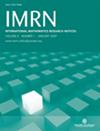惠特克网格的泰特同调与 GLn 通用表示的基底变化
IF 0.9
2区 数学
Q2 MATHEMATICS
引用次数: 0
摘要
让 $p$ 和 $l$ 是两个不同的奇数素数,让 $n\geq 2$ 是一个正整数。让 $E$ 是 $p$-adic 字段 $F$ 的度数为 $l$ 的有限伽罗瓦扩展。让 $q$ 是 $F$ 的残差域的万有引力.让 $\pi _{F}$ 是 $\mathrm{GL}_{n}(F)$ 的一个完整的 $l$-adic 通式表示,让 $\pi _{E}$ 是 $\pi _{F}$ 的基变化。让 $J_{l}(\pi _{F})$ (resp. $J_{l}(\pi _{E})$) 成为 mod-$l$ 还原 $r_{l}(\pi _{F})$ (resp. $r_{l}(\pi _{E})$) 的唯一通项。假定 $l$ 不除 $|\mathrm{GL}_{n-1}(\mathbb{F}_{q})|$,我们证明 $J_{l}(\pi _{F})$ 的弗罗贝尼斯捻是泰特同调群 $\widehat{H}^{0}(\mathrm{Gal}(E/F)) 的唯一通项子曲、J_{l}(\pi _{E}))$ 被视为 $\mathrm{GL}_{n}(F)$ 的表示。本文章由计算机程序翻译,如有差异,请以英文原文为准。
Tate Cohomology of Whittaker Lattices and Base Change of Generic Representations of GLn
Let $p$ and $l$ be two distinct odd primes, and let $n\geq 2$ be a positive integer. Let $E$ be a finite Galois extension of degree $l$ of a $p$-adic field $F$. Let $q$ be the cardinality of the residue field of $F$. Let $\pi _{F}$ be an integral $l$-adic generic representation of $\mathrm{GL}_{n}(F)$, and let $\pi _{E}$ be the base change of $\pi _{F}$. Let $J_{l}(\pi _{F})$ (resp. $J_{l}(\pi _{E})$) be the unique generic component of the mod-$l$ reduction $r_{l}(\pi _{F})$ (resp. $r_{l}(\pi _{E})$). Assuming that $l$ does not divide $|\mathrm{GL}_{n-1}(\mathbb{F}_{q})|$, we prove that the Frobenius twist of $J_{l}(\pi _{F})$ is the unique generic subquotient of the Tate cohomology group $\widehat{H}^{0}(\mathrm{Gal}(E/F), J_{l}(\pi _{E}))$—considered as a representation of $\mathrm{GL}_{n}(F)$.
求助全文
通过发布文献求助,成功后即可免费获取论文全文。
去求助
来源期刊
CiteScore
2.00
自引率
10.00%
发文量
316
审稿时长
1 months
期刊介绍:
International Mathematics Research Notices provides very fast publication of research articles of high current interest in all areas of mathematics. All articles are fully refereed and are judged by their contribution to advancing the state of the science of mathematics.

 求助内容:
求助内容: 应助结果提醒方式:
应助结果提醒方式:


